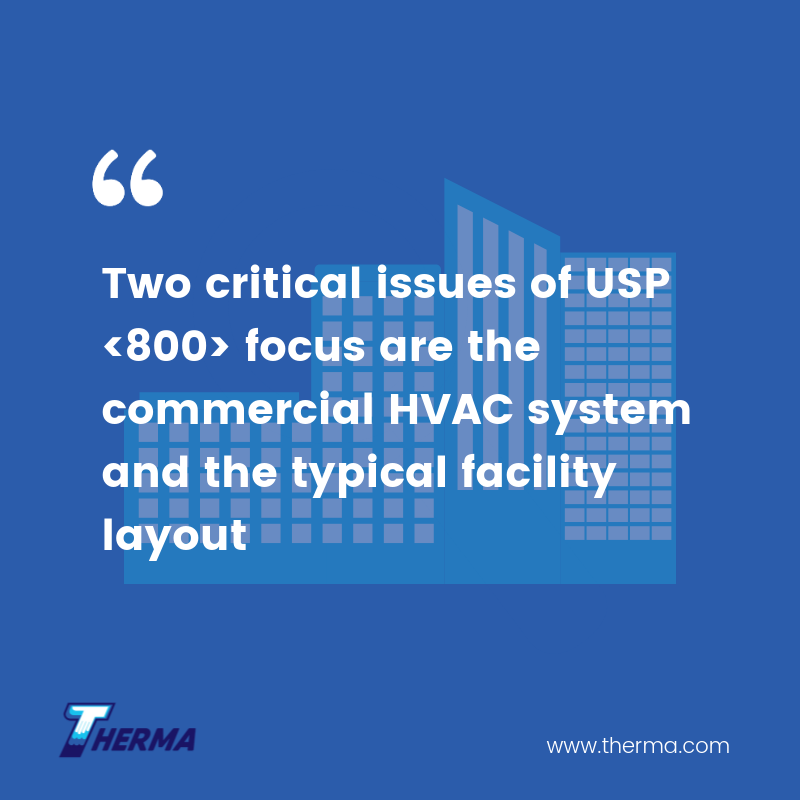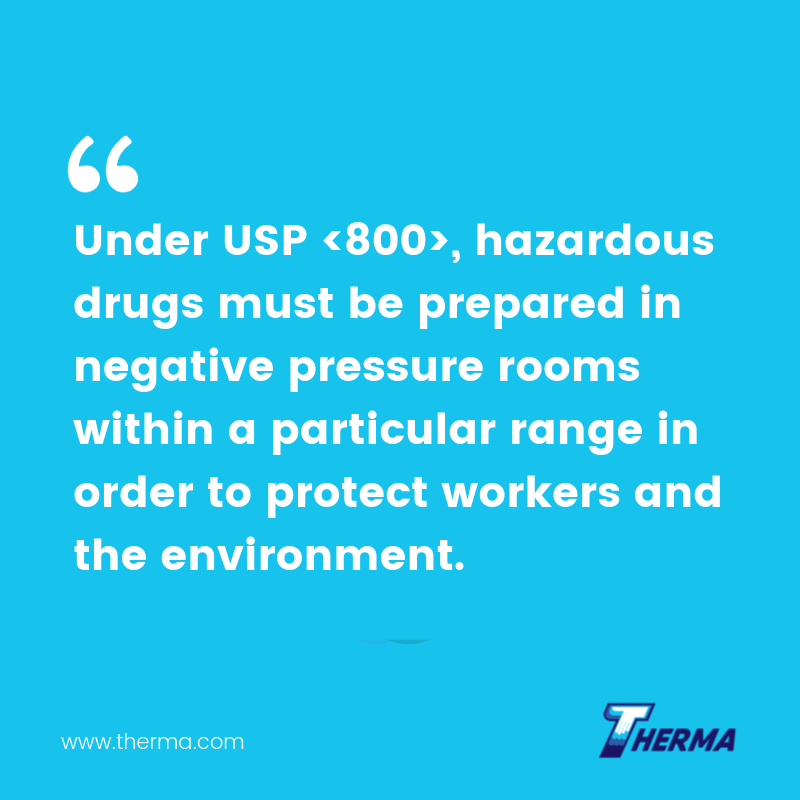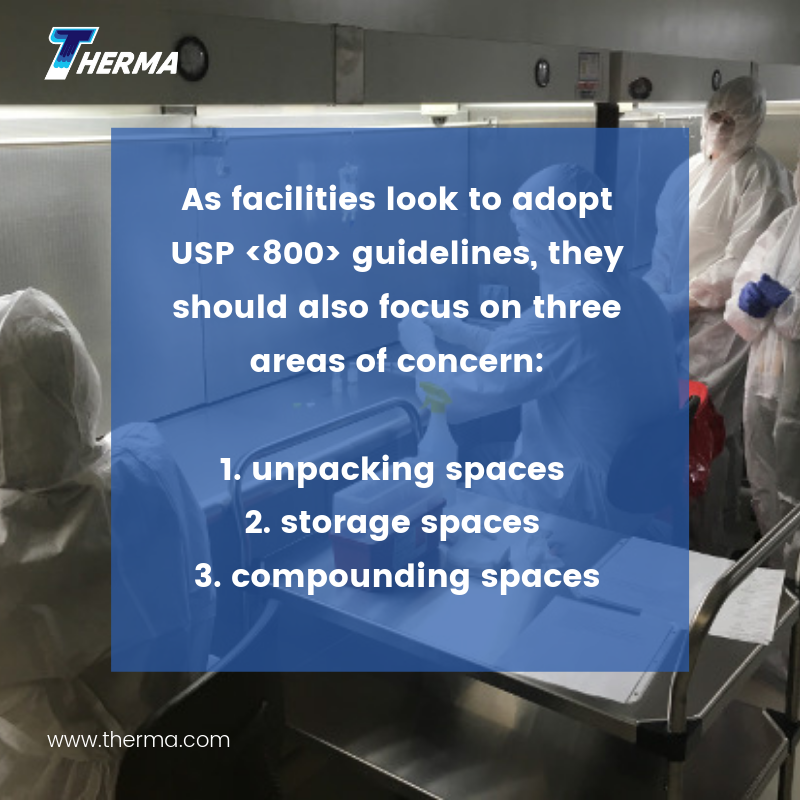By: Trevillian Highter
Pharmacies can no longer prepare hazardous and nonhazardous drugs in the same area, according to the United States Pharmacopeial (USP) Convention’s Chapter 800. Commonly called USP <800>, this standard details new practices for the safe handling of hazardous drugs, or HDs, through various phases of the UD handling process.
What Is USP <800>?
USP <800> specifically describes requirements that cover:
- personnel handling HD
- facility and engineering controls
- procedures for deactivating, decontaminating, and cleaning
- spill control
- documentation
Two critical issues of USP <800> focus are the commercial HVAC system and the typical facility layout such as the building layout of the pharmacy sector.

Much of the thinking behind USP <800> is based on published medical reports documenting the harmful effects of HD exposure on healthcare personnel. Evidence also shows that the work environment can become contaminated with HD agents if they are handled without adequate precautions. According to USP, healthcare workers can experience serious health effects, such as infertility, miscarriages, DNA damage and cancer, due to exposure to over 200 HD commonly used in healthcare settings.
Until now, no enforceable standards have existed regarding the design of spaces that store, prepare, transport or administer hazardous drugs with the goal of minimizing the risks of HD exposure to personnel, patients, delivery people and the public.
Before USP <800>, pharmaceutical compounding was regulated by USP 795 and USP 797, which provide guidelines for nonsterile and sterile preparations, but they don’t distinguish between hazardous and nonhazardous drugs.
The USP <800> chapter was set to go into effect July 1, 2018; however, the official date is now postponed until December 1, 2019. This additional time is important, as building or modifying a facility like a pharmacy for HD compounding is complex and will be time-consuming to get into compliance.
Negative Pressurization
Pharmacies are typically designed at a positive pressurization, however, under USP <800>, HD must be prepared in negative pressure rooms within a particular range in order to protect workers and the environment. As a result, there are new HVAC requirements that can affect pharmacy space planning.

Since USP <800> has negative air pressurization requirements of between 0.01 and 0.03 inches of water column for HD compounding activities, healthcare facilities will need to examine their current air handling systems, including air conditioning units, duct systems and exhaust fans. It’s almost certain that some level of facility modification will be needed.
Air Handling Systems
The most common commercial HVAC systems are inadequate for meeting USP <800> standards’ requirement that enough air be forced into spaces to maintain the required air change per hour and a consistent negative pressure. Therefore, modifications to maintain equipment functionality and meet these new airflow requirements may include rebalancing the existing system or increasing the HVAC fan motor size.
Negative pressure spaces necessitate dedicated exhaust ductwork to the exterior, which can require exhaust ducts to remove contaminated air to the outside of the building while minimizing the routing of the exhaust equipment. Further, the HD exhaust system must lead to a roof-mounted fan location.
As facilities look to adopt USP <800> guidelines, they should also focus on three areas of concern: unpacking spaces, storage spaces and compounding spaces.
Space Considerations
Many pharmacies will need to modify their spaces to meet the HD guidelines.
One requirement that affects pharmacy space planning is that all HD must be compounded in a physically separated, externally vented room that maintains a negative pressure of between 0.01 and 0.03 inches of water column and have at least 12 air changes per hour, such as a buffer room.
HD should not be unpacked from shipping containers in positive pressure areas such as the pharmacy. Instead, the USP requires unpacking HD to occur in a neutral or negative-pressure area. Further, this negative pressure area can’t be the same location as where sterile compounding takes place to prevent contamination.
USP <800> requires HD preparation areas to be separate from non-HD preparation areas, and under certain conditions, compounding both sterile HD and non-sterile HD in the same room is acceptable—however, using an entirely separate room for HD sterile and non-sterile compounding is still recommended. In addition, for sterile HD compounding, a positive-pressure anteroom is needed to access the buffer room, except when compounding lower-risk HD.
Facilities may need to evaluate their current storage conditions and overall facility square footage, since USP <800> requires HD to be stored separately from non-HD. The storage of HD, including rooms in which HD is stored in refrigerators, are subject to the same negative air pressure requirements as compounding areas. While there is no mandated separation between the storage of sterile and non-sterile HD, HD storage within a sterile compounding area is limited to sterile, hazardous drugs only.
Biography:
Trevillian has a master’s degree in computer science. Her experience includes analytical research.
Sources:
- http://www.usp.org/compounding/general-chapter-hazardous-drugs-handling-healthcare
- http://www.usp.org/frequently-asked-questions/hazardous-drugs-handling-healthcare-settings
- https://simplex.is/assets/white_papers/SIM_WP_USP800.pdf
- https://www.healthcaredesignmagazine.com/trends/operations-facility-management/unpacking-usp-800/
- https://www.ncbi.nlm.nih.gov/pmc/articles/PMC5398627/
- https://www.pharmacypracticenews.com/Policy/Article/03-19/Time-Running-Out-on-USP-800-/54259
- https://www.mecart-cleanrooms.com/building-a-usp-800-compliant-compounding-space/








